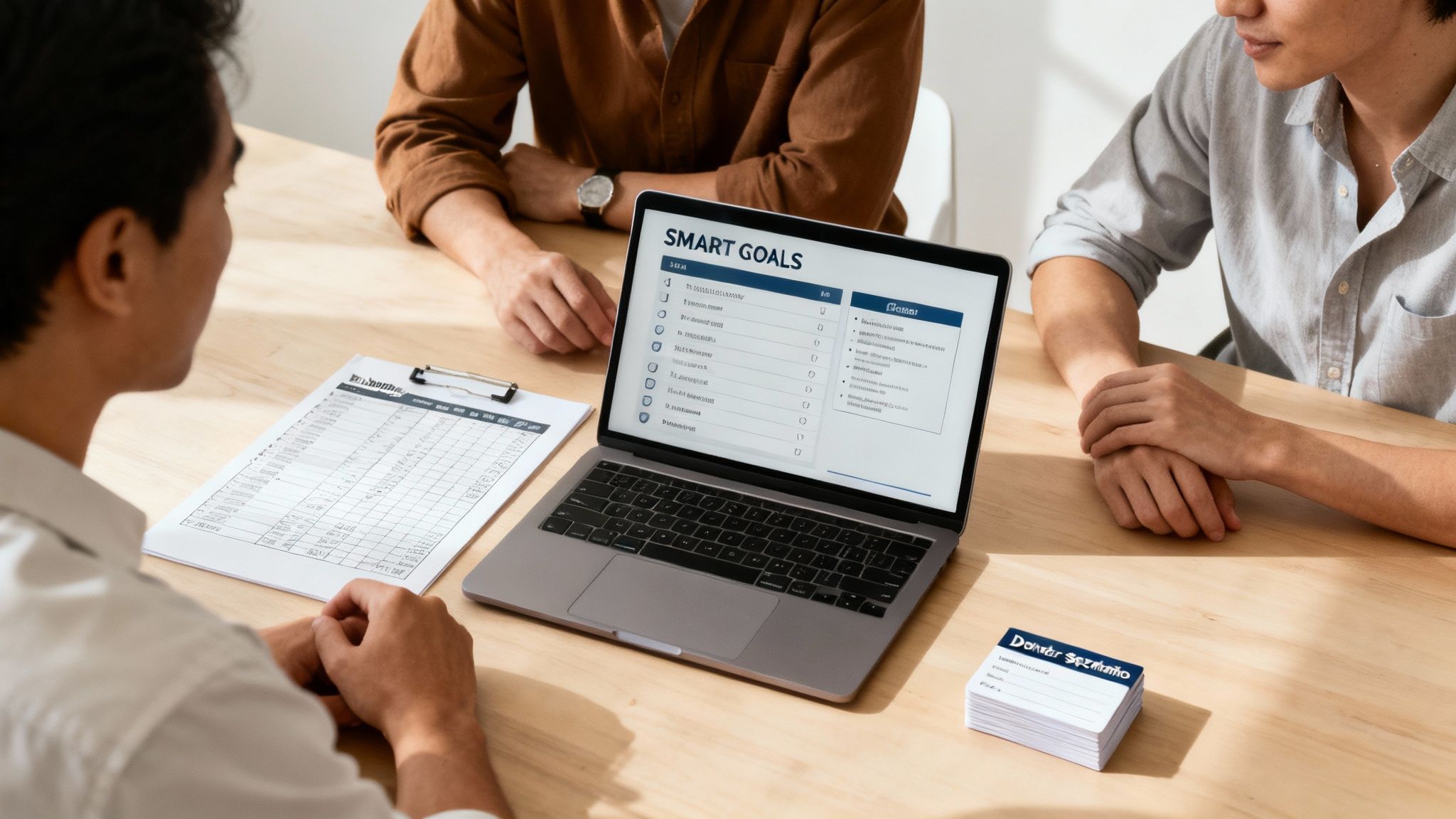So, you're ready to raise some money for a cause you believe in. That's fantastic. But before you dive headfirst into planning a big gala or launching a social media blitz, let's take a step back.
I’ve seen countless fundraising campaigns over the years, and the ones that truly knock it out of the park all have one thing in common: a rock-solid foundation. It’s not just about passion. It’s about being smart and strategic from the very beginning. This means getting crystal clear on your goals, nailing down a realistic budget, and, most importantly, truly understanding the people you’re asking for support.
Get these three things right, and you're not just fundraising; you're building a movement.
Building Your Fundraising Foundation
Every successful campaign starts long before you ask for the first dollar. It begins with a blueprint. Without one, you’re just guessing, and hope is not a strategy. Think of it like building a house—you wouldn't just start throwing up walls without architectural plans, right? Your fundraising foundation is that plan, making sure every move you make is deliberate and contributes to a strong, successful outcome.
This all boils down to three core pillars: setting inspiring goals, creating a meticulous budget, and getting to know your donors.

Think of it this way: clear goals give your budget purpose, and understanding your donors tells you how to best reach those goals within that budget. Each step builds on the last, creating powerful momentum.
Define Your Goals with Precision
Let’s be honest: "raise as much as possible" is not a goal. It's a wish. It doesn’t fire up your team, and it gives your donors nothing concrete to latch onto. You need to get specific. This is where the classic SMART goals framework comes in handy—it’s classic for a reason.
SMART stands for Specific, Measurable, Achievable, Relevant, and Time-bound. It forces you to move from vague ideas to an actual, actionable plan.
Here's a quick look at how to apply the SMART framework to your fundraising goals.
Fundraising Goal Setting Framework
| Component | Description | Example for a Charity |
|---|---|---|
| Specific | What exactly do you want to accomplish? | Instead of "help local animals," try "provide food and medical care for 50 shelter dogs for the next six months." |
| Measurable | How will you track progress and know when you’ve succeeded? | Your goal needs a number. "Raise $25,000" is a clear, measurable target. |
| Achievable | Is this goal realistic given your resources and past performance? | If you raised $10,000 last year, aiming for $25,000 shows ambitious but achievable growth. A $1 million goal might be a stretch. |
| Relevant | Does this goal directly support your organization's core mission? | Raising money for a new transport van is relevant if your mission involves delivering supplies to communities in need. |
| Time-bound | What is the deadline for reaching this goal? | "Raise $25,000 by December 31st" creates a sense of urgency and a clear finish line for your campaign. |
A well-defined goal becomes your campaign's north star. It keeps everyone focused and, crucially, shows donors exactly what impact their contribution will have. That clarity makes the decision to give so much easier.
Create a Realistic Budget
Your budget is your financial roadmap. It’s what keeps your fundraising efforts profitable and prevents that nightmare scenario where you spend nearly as much as you raise. You have to account for everything.
Start by breaking it down into a few key categories:
- Marketing & Promotion: Think social media ads, printed flyers, email marketing tools, and PR outreach.
- Event-Specific Costs: If you're hosting an event, this includes the venue, catering, entertainment (like a DJ or photo booth), rentals, and A/V gear.
- Platform & Processing Fees: Don't forget that online donation platforms and credit card processors all take a small cut.
- Administrative Costs: This could be staff time dedicated to the campaign or any freelance help you need to hire.
Once you’ve tallied up all your estimated expenses, you know your break-even point. This is the absolute minimum you need to raise just to cover your costs, which helps you set a real fundraising target. Digging into different nonprofit fundraising strategies can also spark some creative, low-cost ideas to maximize what you bring in.
Understand and Segment Your Donors
Here’s a hard truth: not all donors are the same. A generic, one-size-fits-all message is a surefire way to get ignored. You wouldn't talk to a long-time major philanthropist the same way you’d talk to a college student making their first $10 donation, right?
This is where donor segmentation is your best friend. It’s simply the process of grouping your supporters based on shared characteristics so you can talk to them in a way that resonates.
You can slice and dice your donor list in a bunch of ways:
- Giving History: Are they a new donor, a recurring monthly giver, a lapsed supporter you want to win back, or a major gift prospect?
- Demographics: Things like age, location, and even known interests can be powerful.
- Engagement Level: Think about your volunteers, event attendees, and loyal newsletter subscribers. They’re already warm leads!
When you understand these different groups, you can tailor everything. A major donor might get a personal phone call or a handwritten letter. A younger audience might be perfect for a peer-to-peer campaign on Instagram. This targeted approach shows your donors you see them as individuals, not just ATMs, and it will dramatically boost your results.
Choosing Your Fundraising Channels
Alright, you've got a solid plan in your hands. Now for the exciting part: deciding exactly how you're going to bring in the money. This isn't about finding one magic bullet. It’s about building a smart, multi-channel strategy that meets your donors where they are. The most successful campaigns I've seen blend the personal touch of live events with the incredible reach of online fundraising.
The real key is to pick a mix of channels that feels right for your charity’s mission, speaks to your specific audience, and—let's be real—is manageable with the resources you have. Think of it less like a single choice and more like building a diverse portfolio of ways for people to support your cause.

Embrace Traditional Fundraising Events
There's a good reason why galas, charity auctions, 5K runs, and even simple community bake sales are still around. They just plain work. There's a unique energy to in-person events that creates a powerful sense of community and urgency. It’s your chance to share your story face-to-face and build connections that last.
These events are absolute gold for a few things:
- Major Donor Cultivation: A well-produced gala creates the perfect atmosphere for those crucial one-on-one conversations with your most significant supporters.
- Community Engagement: Something like a family-friendly fun run or a neighborhood festival can draw in a whole new crowd of supporters who might never have found you otherwise.
- Corporate Sponsorships: Events offer businesses tangible perks they love, like brand visibility and a great way to engage their employees.
The flip side, of course, is that they demand a ton of planning and a bigger upfront budget. They often hinge on getting financial buy-in from partners. If you're just starting out, learning how to find event sponsors is the first, most critical skill you need to master to offset costs and make sure you actually profit from the event.
The Viral Power of Peer-to-Peer Fundraising
Peer-to-peer (P2P) fundraising is where you turn your biggest fans into your fundraising army. Instead of just asking them to donate, you give them the tools to raise money from their own networks of friends, family, and colleagues. It’s an incredible way to grow your reach exponentially.
This model is so effective because of one simple truth: people are way more likely to give when asked by someone they know and trust. An ask from a friend just hits different.
Think of it this way: a single email from your organization might reach a thousand people. But if you get 50 of your supporters to each reach out to 50 of their friends, your campaign’s potential reach just jumped to 2,500 highly qualified prospects.
P2P campaigns are perfect for time-based challenges, like a "30 miles in 30 days" fitness goal or a birthday fundraiser. They succeed because they're personal, social, and built around authentic stories.
Master Your Online Giving Channels
In this day and age, a strong digital fundraising game is completely non-negotiable. And I don't just mean sticking a "Donate" button on your website and calling it a day. It’s about designing a seamless and compelling giving experience across all your online platforms.
A truly effective online strategy needs a few key pieces working together:
- Optimized Donation Pages: Your main donation page needs to be clean, simple, and look great on a phone. Give people options, like one-time gifts and, crucially, recurring monthly donations.
- Targeted Email Campaigns: This is where that donor segmentation work pays off. Send personalized emails that tell a powerful story. Show the tangible impact of a specific amount (e.g., "$25 provides a week of warm meals") and always have a big, obvious button to donate.
- Social Media Drives: Platforms like Facebook and Instagram have built-in fundraising tools that make giving and sharing ridiculously easy. Grab attention with great photos and short, emotional videos.
Your goal here is simple: make giving as easy as possible. The fewer clicks it takes for someone to go from feeling inspired to seeing that "Thank You" screen, the more money you'll raise.
When you combine the community vibe of events, the viral potential of P2P, and the 24/7 accessibility of online giving, you're not just running a campaign—you're building a robust fundraising engine that can bring in support year-round.
Spreading the Word: Crafting and Launching Your Campaign
So, you’ve got a brilliant plan. That's fantastic, but a plan gathering dust on a shelf doesn't raise a single dollar. Now it's time to breathe life into it, to turn your strategy into a living, breathing campaign that grabs people's attention and makes them want to get involved.
This is where we move beyond just asking for money. We need to invite people into a story—your story—and make them the hero. It all starts with building a genuine, emotional bridge between a potential donor and your mission.
Think of it this way: a local animal shelter could say, "We need money for supplies." That’s a fact, but it’s not a story. Instead, tell them about Buster, a terrified stray who arrived matted and alone. Walk them through his rescue and recovery, and then show them how a $50 donation could be the very thing that funds the medicine that helped him heal. That’s tangible. That’s a story.
Building Your Story and Your Brand
Your story needs to be the same no matter where people find you. Consistency is key to building trust. This means nailing down your core messages and visuals so they become instantly recognizable.
- Your Core Message: Boil it down to 3-4 powerful, punchy statements. What’s the problem, who do you help, and why should anyone care? Make these messages emotional, memorable, and easy for your supporters to share with their own friends.
- A Simple Visual Identity: You don't need a massive branding agency. Just pick a consistent color scheme, a specific font, or a simple campaign logo. Use it everywhere—your website, social media, emails, flyers. It signals professionalism and helps people remember you.
- One Clear "Ask": Every post, every email, every flyer should have a single, crystal-clear call to action (CTA). Don't confuse people. Whether it's "Donate Now," "Share This Story," or "Volunteer With Us," make the next step incredibly obvious.
Want to give your supporters something tangible? Consider some effective promotional products. A well-designed tote bag or t-shirt doesn't just thank a donor; it turns them into a walking billboard for your cause.
Getting Your Fundraiser in Front of the Right People
With your story and visuals ready to go, it’s time to make some noise. A great promotion strategy is a mix of casting a wide net and zeroing in on the people who are most likely to connect with your cause.
Don't sleep on old-school media. A sharp, well-written press release can still land you amazing coverage on local news sites, radio shows, or popular community blogs. Keep it short, lead with the most interesting part of your story, include a great photo, and make it dead simple for a busy journalist to get in touch.
At the same time, look for social proof. Reach out to local influencers or respected community leaders whose followers would care about your work. An authentic shout-out from a trusted voice can open up your campaign to a brand new audience that's already primed to listen.
Your online presence is non-negotiable, especially when connecting with younger donors. Millennials are an incredibly generous group, but they live online. Today, 45% of all online donations are made on a mobile device, which tells you everything you need to know about having a smooth, easy-to-use mobile donation process.
Winning Over Corporate Sponsors
Corporate partnerships can be a game-changer, bringing in serious funding and adding a ton of credibility to your event. The secret is to stop thinking of it as asking for a handout and start framing it as a mutually beneficial partnership.
First, do your homework. Look for local and national businesses whose customers and company values are a good match for your mission. Then, put together tiered sponsorship packages that spell out exactly what they get for their support.
Sample Sponsorship Tiers
| Tier Name | Contribution | What They Get |
|---|---|---|
| Bronze Partner | $500 | Logo on our website and event flyers. |
| Silver Partner | $1,500 | All the Bronze perks, plus a dedicated social media shout-out. |
| Gold Partner | $5,000 | Everything in Silver, plus their logo on the main event banner and a public thank-you from the stage. |
When you make your pitch, customize it. Show them you've done your research. Explain how partnering with your nonprofit will help them hit their marketing and community engagement goals. A smart pitch shows you understand their brand and are offering a real opportunity, not just asking for a check.
If you're looking for fresh concepts that sponsors will love, check out these creative nonprofit fundraising event ideas for some inspiration.
Producing an Unforgettable Fundraising Event
If you're putting on a fundraising event, the day-of execution can either make or break your entire campaign. This is where all that meticulous planning pays off, turning your vision into a real-life experience that not only opens wallets but builds a loyal community for years to come. It’s all about creating a vibe that people will be talking about long after they head home.
Let's get past the basic logistics like tables and chairs. We’re talking about the magic that happens when you intentionally design an engaging environment. Think of your event space as a blank canvas; the right elements can paint a picture that tells your charity’s story and makes every guest feel like they're part of something special.

Setting the Scene with Sound and Light
Never, ever underestimate the power of atmosphere. A little strategic lighting and professional sound can transform a generic hotel ballroom into an immersive world that screams your cause. This isn’t just about making sure people can see and hear; it’s about shaping their emotional journey from the second they walk through the door.
Think about how these elements play together:
- Uplighting: Splashing your organization’s brand colors on the walls with uplighting is a simple trick that instantly makes the room feel custom and professional.
- A Pro DJ/MC: A great MC is the glue that holds the entire night together. They don't just make announcements; they steer the energy of the room, smoothly transitioning from a heartfelt speech to a high-energy auction. A good DJ keeps the music on point, killing any chance of awkward silences.
- Crystal-Clear Audio: There is absolutely nothing worse than a powerful, mission-critical story being lost to a crackling microphone. Investing in a quality sound system means every speaker’s word and every emotional testimonial is heard perfectly.
These aren't just "nice-to-have" extras. They are fundamental tools for crafting an experience that sticks with people.
Creating Shareable Moments of Engagement
In a world run by social media, you want to give your guests every reason to share their experience. Creating interactive, photogenic moments isn't just about making the event more fun—it extends your reach to the online networks of everyone in the room. This is how you generate buzz that actually lasts.
A well-placed photo booth or a live social media feed doesn't just entertain guests; it transforms them into active promoters of your cause. Every photo shared with your event hashtag is a personal endorsement broadcast to hundreds of their followers.
So, how do you get people to pull out their phones and start posting?
- Photo Booths with Custom Backdrops: Get some fun props and a cool backdrop that features your charity's logo and event hashtag. It's an easy win for user-generated content.
- Live Social Feeds: Project a live feed of posts using your event hashtag onto a big screen. People love seeing their posts pop up—it encourages them to share in real time.
- Interactive Giving: Use live "fund-a-need" thermometers to show progress during a paddle raise or text-to-donate push. This creates a powerful sense of collective effort and urgency.
We've seen these elements work wonders for all sorts of fundraisers. To help you decide what's right for your event and budget, here's a quick comparison of some of the most effective engagement boosters.
Event Engagement Booster Comparison
| Element | Typical Cost | Engagement Impact | Best For |
|---|---|---|---|
| Photo Booth | $500 – $1,500 | High | Galas, themed parties, walk-a-thons. Great for creating shareable branded content. |
| Professional DJ/MC | $800 – $3,000+ | Very High | Any event with a structured program. Essential for maintaining energy and flow. |
| Live Social Wall | $300 – $1,000 | Medium | Tech-savvy audiences, conferences, galas. Encourages real-time social sharing. |
| Videography | $1,500 – $5,000+ | High (Post-Event) | Capturing powerful stories for future marketing and donor stewardship. |
Choosing the right mix depends on your crowd and your goals. A photo booth is almost always a hit, while a live social wall works best when you know your attendees are active on social media.
Managing the Day with a Run-of-Show
The secret to a stress-free, seamless event? A hyper-detailed "run-of-show" document. This is your minute-by-minute playbook for the entire day, and it needs to be in the hands of every vendor, staff member, and key volunteer. It clearly lays out who is doing what, and when.
Your run-of-show should have everything from vendor arrival times and sound check schedules to the exact moment the keynote speaker takes the stage and when dessert hits the tables. To make sure you don't miss a thing, a detailed guide like this planning a charity event checklist can be a lifesaver.
When everyone on your team is working from the same script, you’re free to focus on what really matters: connecting with your donors.
The Work Begins After the Campaign Ends
The last donation is in, the event is over, and you’ve hit your fundraising goal. It’s easy to breathe a sigh of relief and move on, but honestly, the most important work is just getting started. This is where you turn a successful campaign into long-term support for your cause.
Don’t skip the follow-up. Thoughtful stewardship isn’t just good manners; it's smart strategy. Keeping a current donor is far cheaper and more effective than constantly chasing new ones. A solid post-campaign plan is what makes people feel appreciated enough to stay with you for the long haul.

Go Beyond the Automated "Thank You"
Let's be clear: a generic email receipt is not a thank you. To make a donor feel genuinely valued, your gratitude has to be quick, personal, and show them their money is already making a difference. My rule of thumb is to get a personalized thank-you out the door within 48 hours.
Think about tiering your approach based on the gift size. It doesn't have to be complicated:
- Small Donations: A warm, personalized email is perfect. Just make sure it mentions the specific campaign they supported.
- Mid-Level Donations: This is where a handwritten card from a staff or board member really shines. It’s a simple touch that has a huge impact.
- Major Donations: A personal phone call from your Executive Director or a key board member is absolutely essential. No exceptions.
A truly great thank-you note doesn't just say, "Thanks for the cash." It says, "Because you gave, this amazing thing is now happening." Always connect their specific donation to the impact it created.
To keep the conversation going and make sure no one falls through the cracks, look into setting up some simple automated lead nurturing sequences. This helps you build relationships at scale and gently encourage that next donation.
Show, Don't Just Tell, the Impact
After that initial thank you, your job is to close the loop. Donors are dying to know what happened with the money they gave. When you report back transparently, you build an incredible amount of trust and make them feel like a true partner.
A month or two after the campaign wraps, send out a final report. Pack it with photos, the final numbers, and most importantly, stories. Don't just say you raised $50,000. Show them a picture of the kids using the new playground equipment they funded or share a powerful quote from someone who benefited from the program. This makes the impact tangible and real.
Don't Forget the Boring (But Crucial) Stuff
While it’s not the most exciting part of fundraising, getting the financial and legal paperwork right is non-negotiable. It’s all about maintaining trust and protecting your organization.
Make sure every single donor gets a proper tax receipt that meets all IRS requirements. It needs your charity’s name, the donation amount, and a statement confirming what, if any, goods or services were provided in exchange. Nailing this detail reinforces your professionalism and shows you run a tight ship.
Learn From Every Campaign
Finally, every campaign is a chance to get better. If you aren't measuring your results and asking for feedback, you’re flying blind.
Start with the basics. Calculate your "cost to raise a dollar" by dividing your total campaign expenses by the total funds you brought in. It’s a simple but powerful metric.
Then, send out a quick survey to donors and event attendees. Ask what they loved and what you could do better next time. This feedback is pure gold. For a more detailed breakdown, our guide on how to measure event success has some great templates and KPIs to track. Treat every fundraiser as a learning opportunity, and you’ll see your results improve year after year.
Got Fundraising Questions? We’ve Got Answers.
https://www.youtube.com/embed/3rL4lYERfdg
Let's be real—fundraising can feel like you're trying to solve a puzzle with a few missing pieces. Whether you’ve been doing this for years or you’re just getting your first campaign off the ground, questions always pop up.
Here, we'll dive into some of the most common ones I hear and give you some straightforward, practical advice to help you move forward with confidence.
How Much Should We Really Spend on Fundraising?
This is the million-dollar question, isn't it? While there’s no single magic number, a solid benchmark to aim for is what we call the "cost to raise a dollar." Most successful nonprofits try to keep this between $0.20 and $0.30 for every dollar they bring in. So, if you spend $250, you should be looking to raise about $1,000.
Of course, this number can swing wildly depending on your strategy. An online giving campaign might cost next to nothing, while a big gala comes with hefty price tags for the venue, catering, and entertainment. The trick is to map out a detailed budget from the very beginning, track every single penny, and then stack it up against your final donation tally. Your first-ever event might have a higher cost, but you should see that number get leaner as you learn and repeat.
A quick pro-tip: Always be radically transparent about your costs. When donors see you're being open and responsible with their money, it builds an incredible amount of trust.
What’s the Best Way to Thank Our Donors?
A thank-you can't just be an automated email that fires off into the void. To truly connect with your donors, your gratitude has to be prompt, personal, and persistent. Your whole goal is to make every supporter feel like they're a core part of your team.
Here are a few ways to make your thank-you's stand out:
- Move Fast: Don't let a donation sit for days. Try to get a personalized thank-you note or email out the door within 48 hours. Speed shows you're paying attention.
- Make It Personal: For larger gifts, nothing beats a handwritten card or a quick phone call from a board member. It tells the donor, "We see you, and you are more than just a transaction to us."
- Show the Impact: The thank-you shouldn't be a one-and-done deal. Keep your donors in the loop. Share stories and progress updates in your newsletter or give them a shout-out on social media (with their permission, of course!).
Want a fantastic, low-cost idea that packs an emotional punch? Record a short video from the people their donation actually helped and send it to them. It’s a powerful way to close the loop and show them exactly what their support made possible.
How Can a Small Charity Raise Money on a Shoestring Budget?
You don't need a massive war chest to run a successful fundraiser. Small charities can absolutely punch above their weight by getting creative and leaning into their community.
The key is to focus on low-cost strategies that create high levels of engagement. Peer-to-peer fundraising is a game-changer here. You can empower your most passionate supporters to become fundraisers for you, tapping into their own networks using free online platforms. A simple, powerful story shared on social media can also catch fire without you spending a dime on ads.
Another great move is to team up with local businesses. Think "percentage of sales" nights at a local restaurant or getting a caterer to donate food for a small get-together. These partnerships build community goodwill and save you cash. Ultimately, it’s about building deep, meaningful relationships with a smaller group of dedicated donors. A loyal base of recurring monthly givers will provide far more stability than one big, expensive gala ever could.
What Legal Stuff Do We Need to Sort Out Before We Start?
Getting the legal details right from the start is non-negotiable—it protects both your charity and your donors. First things first, make sure your organization is properly registered as a 501(c)(3) (or your country's equivalent). You’ll also likely need to register in any state where you plan to actively ask for donations.
Be crystal clear in all of your fundraising materials about your mission and exactly how the money will be used. If you're planning a raffle or any kind of contest, you have to check your local and state gaming laws, as they are often surprisingly strict.
Finally, make sure you have a system for sending out donation receipts that meet all the IRS requirements for tax deductions. When in doubt, it’s always a smart investment to chat with a lawyer who specializes in nonprofit law. A little bit of expert advice upfront can save you a world of headaches down the road.
Planning a charity event that feels special and professional takes a lot of work. At 1021 Events, we’re experts at turning your vision into an unforgettable experience. With top-tier DJ/MC services, stunning uplighting, and fun photo booths, we keep your guests engaged, entertained, and inspired to support your cause. Learn how we can elevate your next fundraiser.




